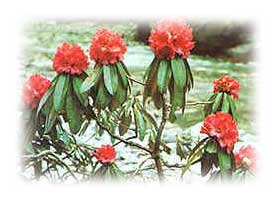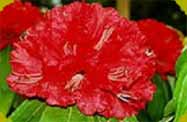|
HABITAT

In general sense, the
rhododendrons are essentially terrestrials in nature. Under
suitable environment the epiphytes are always found growing on
soil albeit the ground is a raised earth, rock or sloping. The
epiphytes species of the group are R. camelliiflorum,
R.dalhousiae, edgeworthii, griffithianum (to some extent),
leptocarpum, lindleyi, and vaccinioides. For these the major
phorophytes are species of Castanopsis, Quercus, R.arboreum,
etc. Generally, trees with a longer lifespan and rough bark
were found to be preferred as phorophytes. But this is not a
general rule as because it is seen that the epiphytes,
conditions permitting, makes use of almost any available tree
species that is found in the locality as epiphytes.
Some of the species which grow also no rocks are R. fulgens, lepidotum,
nivale, pendulum, setosum, camelliiflorum, and to some extent
anthopogan and baileyi. At favourable location, it
seems, almost all species take to rocks as refuge.
Species which require shades to a varying degree are R. lanatum (under
Abies sp) fulgens, decipiens, wallichi, wightii, and
campanulatum (all under mixed community of dominant Abies sp).
All other species may be classified as ‘outdoors’ as because
they grow quite well in the open.
Most of the bush /bushlets are found on open sloping terrain. The slopes
somewhat well drained and thus less moist condition where few
species make their home, e.g. R.virgatum, R. pendulum, etc.
The epiphyte rhododendrons which are found sometimes growing
on soil are generally restricted to the sloping terrain where
water-logging is less experienced (as is the situation on a
tree environment). The shrub favour level grounds, the river
–terrace being their favourite retreats.
At Barshay, the R.falconeri though grows in marshy locality, never step
into the marsh but choose the adjacent grounds which are less
moist. Similarly, the R.ciliatum at Yakchay they grow on
marshy places and at the adjacent non – marshy sites R. niveum
covers the remaining ground. As all marshy places are usually
on even grounds the species that grow here was seldom found
growing on the slopes.
The species which are trees or reaching a tree like dimension are
sometimes found as canopy members inside a forest stand, some
still are found as dominating species occupying the upper
story as is the case found at places like Tendong peak. (R.grande)
and Hillay – Barshay (R. falconeri) covers the crown of a
small knoll and outgrows all associated trees in height.
Rhododendrons here usually grows under a moist environment with plenty of
soil moisture, humidity and at the location above 2800m spend
about 3 months under snow. Winter with severe drop in
temperature at localities above 2800m produces permafrost of
situation in the soil. A physiological drought condition is
thus always experienced by these plants at such localities. To
fend off such tundra –like condition (for the snow and frozen
groundwater are not available to plants at such times) various
modifications come up in the form of scales, hairs on the
leaves and its curling. Growth is therefore always thwarted at
such localities.
The species which experience and grow over regular snow-line and avalanche
are R.niveum and R.thomsonii. The response to sheer stress of
snowline and now made the R.thomsonii at Phuni to be growing
in an inclined manner.
The soil in most of the rhododendron growing sports showed high
nitrogen content( 490 kg/ha). < 4% organic matter, Phosphorus
at 145/kg/ha (P2O5) and low Potassium (48 kg/ha). Mean for pH
was 5.6.
Soil, as is expected, was towards acid. Soil pH for individual cases is
presented in its respective entries.
The habitat of R.niveum and R.thomsonii population (at Yakchay through
Phuni) are regularly subjected to avalanches. This natural
force has an ancient history or is of a origin is difficult to
assess but considering the devastation of R.niveum at Yakchay
during the 1980 snow-line and sheer bending away of
R.thomsonii. towards the river –side points to the fact that
the casualties has a recent origin.
In conclusion, the habitat of both the epiphyte as well as terrestrial
rhododendrons require consideration towards its preservation.
Horizontal Distribution: Lachung valley
Under observation the species were found to be quite ‘site specific’, or
conversely, small locality or rather niche quality played
important part in the species being found or not. The many
clearly demarcated niches of 9 rhododendron species is rather
starkly obvious at this area. Small virtual ‘islands’ of these
niches sometimes overlap. Highly delicate ecosystem balancing
mechanism must be operating in the area to support such a
diversity in form habitat and the harmony. The watershed of
Lachung chhu still has the scope to be studied in its totality
unlike the Singalila ridge which has lost a large part of its
natural biota and virgin terrain.
Small patches usually were found to be harboring a group of particular
species, fro example, in the Yakchay area R.niveum is
localized. Here, not a single species of R.thomsonii is found
whereas about 1km away (aerial distance) at Phuni these grow
in impenetrable thickest. And here not a trace of R.niveum is
found. The altitude differences is 100m only. A little more
up between 3000-3700m above mean sea level R. campanulatum grows luxuriantly
up to Yumthang. Between this patch is found R.baileyi for a
short stretch. Others are R.decipiens at Shingba (3200m),
R.cinnabarium (3500m), and small patches of R.wightii,
R.setosum and R.grande. Interspersed between these are found
the less gregarious ones, e.g. R. lanatum, R. pendulum, R.
fulgens. A little up from Yumthang one can observe R.
aeruginosum (scattered), R. campylocarpum (in swarms), etc.
Yakchay proper is also the location of R.ciliatum.
At Lachung proper the slopes are usually found covered by R.virgatum
facing south east. Same is the case of R. lepidotum.
Horizontal distribution:
Yuksam-Thangsing area
So far, the Yuksam-Thangsing area (map 3) remains one of the best
preserve for Sikkim Himalayan rhododendrons. It is in this
area that the first sighting of R. leptocarpum was made.
Different terrain, absence of pliable road and presence of
intact natural forest cover has contributed much in the
stability of the environment and preservation of rhododendrons
in the region. Most remarkable is the comparatively large size
of epiphytic rhododendron population. Once this particular
trail was an important pilgrimage trail and under the royal
patronage (Yuksam being the former capital of sovereign
Sikkim) and disturbance to the land and biota was not allowed.
This regulation was put to effect as because the trail led to
sacred places, lakes and monasteries. The route from yuksam to
Thansing is c 30km and covers 3000m in elevation. This is also
the more frequented route fro reaching the base camping site
for Kanchendzonga National Park. |
|
|
|

Rhododendron


Amongst the many
floral treaties of Sikkim Himalaya one of the earliest ones may be
found over the genus Rhododendron (Gk. rhodo = red, dendrons = tree
). |
| |
|
|
|

Orchid


Orchid
known for their brilliance in colors, unusual shapes
attractive growth habits, variety in fragrance and
exquisite beauty can attract any nature lovers. |
| |
|
|
|

Medicinal Plant


Sikkim
with its total geographical area of 7,096 sq km is
bestowed with a huge diversity of flora and fauna. |
| |
|
|
|
|
|